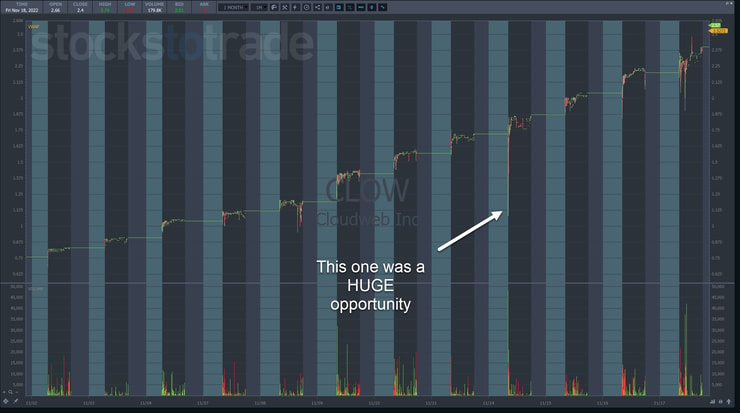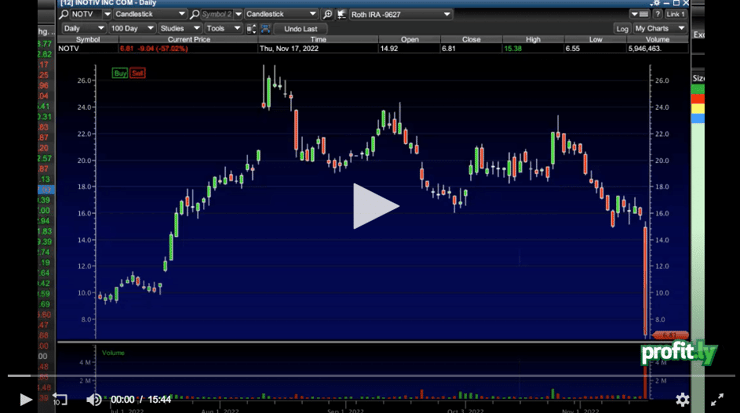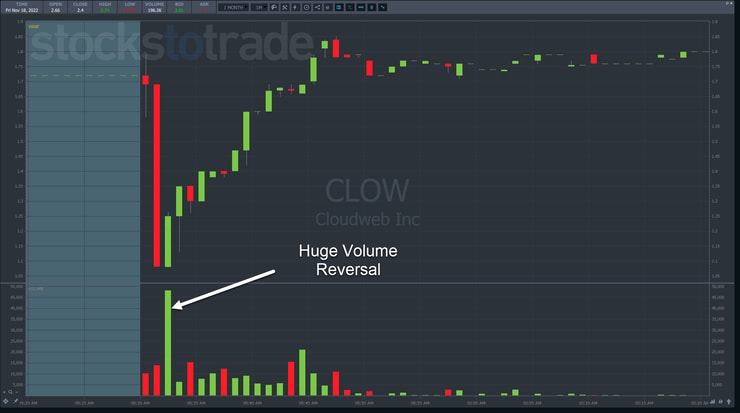Never take a stock off your watchlist after a big run.
That would be a HUGE mistake.
Just because it’s up 100%, 200%, or even 1,000% doesn’t mean it can’t go further.
Multi-day runners often surprise my newer Millionaire Challenge students.
These folks don’t realize that the same stock can provide multiple setups day after day.
Take Cloudweb Inc (OTC: CLOW).
This multi-day runner provided several chances for morning panic dip buys.
It seems pretty straightforward.
However, I watch folks struggle to identify multi-day runners and then properly execute the dip buy setups.
Now, folks who join my Millionaire Challenge get access to thousands of hours of content, including my crucial DVD series.
These go into depth on EXACTLY what I look for in my trade setups, including how I use Level 2 data to time my trades.
And normally, I keep that content under wraps.
However, I want to give you a peek behind the curtains and explain how I find and trade multi-day dip buys.
Plus, you’ll find a video in the body of this blog post that gives even more insights that I typically reserve for my students.
Strap in folks, because I’m about to hit you with some premium content.
A Video Worth The Wait

As promised, this video covers some of the recent multi-day runners and key insights I discussed with my Millionaire Challenge students.
Locating Gold Mines

Every morning and afternoon, I do two things.
First, I look for all the biggest gainers.
Normally, I look for OTC and small-cap penny stocks. However, when a stock catches a big run, it can sometimes move over $10.
So, try not to limit yourself too much.
Second, I go through the major headlines of the day from Breaking News.
Years ago, I had to do this manually, read through countless emails, and scroll twitter feeds.
Thankfully, we’ve simplified that for folks with our StocksToTrade platform.
Not only does the platform provide advanced charting, but there are some amazing features as well.
For example, our screener allows traders to look for stocks with low floats and other liquidity parameters, something few others offer.
Plus, the screener runs continuously and in the pre and post market.
As a stock starts to run, it pops onto the list.
But my favorite part has to be our Breaking News Chat feature.
We’ve hired some of the best analysts around to sift through the noise and curate the headlines traders need.
I can’t tell you how much time it saves having someone do all the leg work for me.
On top of that, they’ll let you know when a stock is getting pumped by promoters.
If you haven’t experienced it yet, I strongly urge you to sign up for a trial.
With the time saved, you can focus on studying and watching the price action.
More Breaking News
- Wall Street Analysts Rave About AT&T’s Strategic Moves: Is This the Time to Dive In?
- DNN Stock Ride: Are the Recent Gains Just the Beginning?
- Smurfit WestRock’s Stock Spike: What Happened, and What’s Next?
Because as you’re about to find out, that’s where the real magic happens.
Timing Your Entry

Everyone asks me, ‘Tim, how do you know where to buy a panic dip?’
I’m going to let you in on a little secret.
It’s not just where but when.
Not only do I look for traditional support and resistance, but also I look for price action to signal a bottom.
Let me give you an example.
When CLOW dropped hard early last week, it created a massive opportunity for a morning panic dip buy.
Take a look at the chart below.
Shares fell towards $1.00 before huge buying volume stepped in to halt the slide.
Now, let’s take this a step further.
CLOW’s recent run started around $0.50.
Dropping from $1.70 down to $1.20 is a nearly 50% retracement of all the gains to that point.
As I explain to my students, promoters will step in to prop up shares, especially when they fall so quickly.
But there’s one last trick I use to help my trades – Level 2 data.
A lot of folks dismiss Level 2 data because they think it’s too difficult to read or doesn’t provide good information.
However, I provide every one of my students with my full DVD set (available online) that discusses how I use Level 2 data for my entries.
Essentially, I look to see buyers stack up.
Then, I like to step in and push it over the top and up to the next price.
If all this sounds confusing, I understand.
I threw a lot of heavy information at you all at once.
Don’t worry.
I’ve mentored more than 20+ students to become millionaire traders and I can help you to.
Join my Millionaire Challenge and take the first step towards building a trading career that works for you.
—Tim





Leave a reply